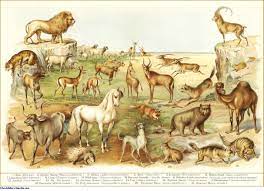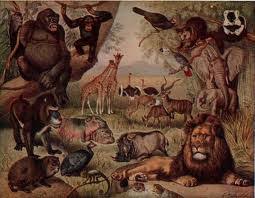The Bible, a revered and ancient text, not only imparts profound spiritual teachings but also intertwines the natural world with its narratives. Amidst tales of faith, miracles, and moral guidance, the scriptures weave captivating accounts of animals that held significant roles in shaping biblical events.
From the symbolism of the serpent in the Garden of Eden to Noah’s Ark housing a diverse array of creatures, these stories highlight the intricate connections between humanity and the animal kingdom as described in the Holy Scriptures.
Delving into these intriguing accounts, we uncover timeless lessons, allegorical representations, and the divine stewardship of God’s creations. Join us on an enlightening journey as we delve into the fascinating stories of animals in the Bible, seeking to unravel the deeper meanings and spiritual insights they impart.
Table of Contents
Overview of the Bible’s Cultural and Historical Significance:
The Bible stands as a cornerstone of human civilization, revered and cherished across diverse cultures and beliefs. Its cultural and historical significance extends beyond the realm of faith, encompassing literature, art, ethics, law, and societal norms. Spanning thousands of years, the Bible chronicles the spiritual evolution of humanity, offering a glimpse into ancient civilizations, their beliefs, struggles, triumphs, and moral principles. It encapsulates the essence of numerous societies, shaping the ethical compass of generations and providing a foundation for many legal and moral systems.
The Bible’s influence in shaping art, literature, and philosophy is immeasurable, permeating through the works of countless artists, authors, and thinkers throughout history. Its narratives have inspired paintings, sculptures, and music, and have been a source of guidance for individuals seeking purpose and understanding in their lives. The cultural and historical significance of the Bible continues to be a topic of academic study and admiration, showcasing its enduring impact on the human story.
The Creation Story:
The creation story, found in Genesis 1-2, recounts how God created the world and all living creatures in six days. On the fifth day, God created the sea creatures and birds, blessing them to be fruitful and multiply. On the sixth day, God created land animals, including livestock, wild animals, and creeping things. He made humans in His image, giving them dominion over all the creatures of the earth. The story emphasizes the order and purpose in creation, highlighting the beauty and interconnectedness of God’s design.
Noah’s Ark:
The account of Noah’s Ark, in Genesis 6-9, narrates the story of Noah, a righteous man whom God chose to save from a worldwide flood. God instructed Noah to build an ark to house his family and pairs of every kind of animal, ensuring the preservation of life during the deluge. Noah followed God’s commands meticulously, and the ark provided a safe haven for the animals and his family. After the floodwaters subsided, Noah, his family, and the animals disembarked, and God made a covenant promising never to flood the earth again. The story illustrates God’s mercy, faithfulness, and the importance of obedience.

The Talking Donkey:
In Numbers 22:21-39, the narrative unfolds as Balaam, a prophet, is on a journey. God sends an angel to block Balaam’s path, but he is unaware. Balaam’s donkey sees the angel and refuses to move, frustrating Balaam, who then beats the donkey. Miraculously, God allows the donkey to speak, revealing the angel’s presence and saving Balaam’s life. This astonishing event demonstrates God’s ability to use any means to communicate His will and protect His chosen servants.
Jonah and the Great Fish (or Whale):
The Book of Jonah recounts how the prophet Jonah disobeys God’s command to go to the city of Nineveh and is swallowed by a great fish (often described as a whale). Jonah remains in the belly of the fish for three days and three nights before being vomited onto dry land. God gives Jonah a second chance to deliver His message to Nineveh, illustrating God’s compassion and willingness to forgive those who repent.
Daniel in the Lions’ Den:
Daniel 6 tells the story of Daniel, a devout man of faith serving in the Persian kingdom. His rivals plotted to have him thrown into a lions’ den for his faithfulness to God and refusal to obey the king’s decree. God miraculously closed the mouths of the lions, sparing Daniel. The king recognized God’s power and honored Daniel, showcasing God’s protection over those who remain steadfast in their faith.
The Fiery Furnace:
In Daniel 3, Shadrach, Meshach, and Abednego, three Jewish youths, faced a test of their faith. They refused to worship a golden idol, defying King Nebuchadnezzar’s order. Consequently, they were thrown into a fiery furnace, but God’s intervention protected them from harm. The astonished king acknowledged God’s supremacy and promoted the trio, emphasizing God’s faithfulness to those who stand firm in their convictions.
The Plagues of Egypt:
The plagues of Egypt, as described in Exodus 7-12, were a series of ten devastating events sent by God to convince Pharaoh to release the enslaved Israelites. Among the plagues were those affecting livestock, including a plague on cattle and other livestock. These plagues demonstrated God’s power and determination to secure the freedom of His people, ultimately leading to the Exodus from Egypt.

The Serpent in the Garden of Eden:
In the story of Adam and Eve in Genesis 3, a serpent tempts Eve to eat the forbidden fruit from the Tree of Knowledge of Good and Evil. Eve succumbs to the temptation and shares the fruit with Adam, resulting in their disobedience and subsequent fall from grace. This story serves as an explanation for the presence of sin and the need for redemption in humanity.
The Sacrificial Lamb:
In Exodus 12:1-14, God institutes the Passover, a significant event in Jewish history. Each household was instructed to sacrifice a lamb and use its blood to mark their doorposts. The blood protected them from the final plague—the death of the firstborn. The sacrificial lamb symbolized atonement, foreshadowing Jesus Christ as the ultimate sacrificial lamb whose blood redeems and saves humanity.
Balaam’s Prophecy:
In Numbers 23:7-10, the story involves Balaam, a prophet hired to curse the people of Israel. However, each time he attempts to curse them, blessings come out instead, as God’s will prevails. Balaam’s prophecy includes vivid imagery, likening Israel’s strength and unity to that of a lion and a unicorn. The story highlights God’s sovereignty and the futility of attempting to harm those under His divine protection.
The Lost Sheep:
In the parable of the Lost Sheep (Matthew 18:12-14; Luke 15:3-7), Jesus tells the story of a shepherd who leaves his flock of 99 sheep to search for the one that went astray. This parable symbolizes God’s boundless love and concern for every individual, emphasizing the joy in heaven when a lost sinner repents and returns to God.
The Good Shepherd:
In John 10:1-18, Jesus uses the metaphor of a shepherd to describe His relationship with His followers. He portrays Himself as the good shepherd who knows His sheep intimately, contrasts His care with that of a hired hand, and foreshadows His sacrifice for His sheep. This metaphor underscores Jesus’ love, sacrifice, and guidance for believers, emphasizing the eternal life He offers.
Importance of Animals in Biblical Stories:
Animals play a profound role in the tapestry of biblical stories, embodying symbolism, lessons, and metaphors that enrich the spiritual teachings of the scriptures. From the serpent tempting Adam and Eve in the Garden of Eden to the dove representing peace and deliverance, animals are integral to the biblical narrative.
They symbolize various virtues, vices, and aspects of the human experience, reflecting both the frailty and resilience of mankind. Additionally, animals feature prominently in the miracles, parables, and visions described in the Bible, emphasizing God’s creation and dominion over all living beings.
The stories of animals in the Bible underscore the interconnectedness of life and the responsibilities of stewardship towards the natural world. They remind believers of their duty to care for and respect all creatures, reflecting divine values of compassion, kindness, and reverence for life.
Final Words:
Exploring the stories of animals within the Bible provides a deeper understanding of the ancient scriptures and their timeless relevance. These stories, infused with symbolism and moral lessons, highlight the intricate relationship between humans and the natural world. The Bible, transcending its religious significance, holds a mirror to our shared human experience, inviting contemplation, introspection, and a quest for spiritual growth.
In comprehending the cultural and historical significance of the Bible, we acknowledge its profound impact on shaping human societies and values, offering insights into the beliefs and practices of diverse civilizations across time.
The importance of animals in biblical narratives illuminates the spiritual wisdom encoded in the scriptures, reminding us of our responsibility to respect and care for all living beings. As we delve into these stories, we are encouraged to reflect on the timeless messages they convey and integrate their teachings into our lives, fostering compassion, empathy, and harmony with the world around us.
Reference:
- https://erlc.com/resource-library/articles/10-biblical-truths-about-animals/
- https://www.christianity.com/wiki/heaven-and-hell/does-bible-say-animals-go-to-heaven.html
- https://www.theguardian.com/education/2009/feb/17/bible-stories-in-brief

Rahul M Suresh
Visiting the Zoo can be an exciting and educational experience for all involved. As a guide, I have the privilege of helping students and visitors alike to appreciate these animals in their natural habitat as well as introducing them to the various aspects of zoo life. I provide detailed information about the individual animals and their habitats, giving visitors an opportunity to understand each one more fully and appreciate them in a more intimate way.









